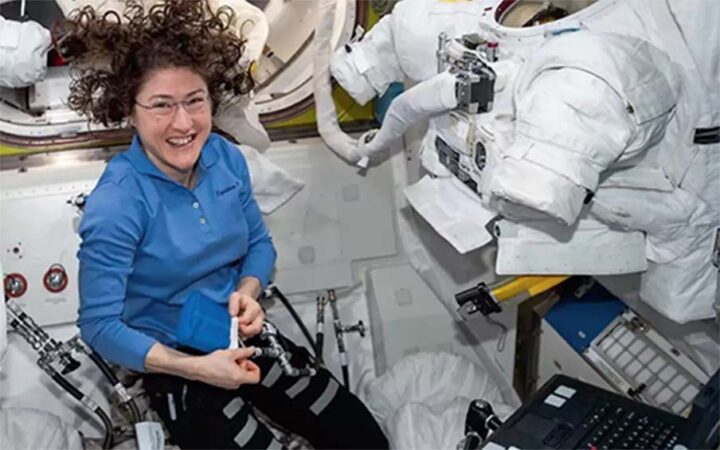Christina Koch has the kind of job children dream of. Beginning in 2019, on her first mission to the International Space Station (ISS), the NASA astronaut lived in space for 328 days — the longest time any woman has spent there. During that mission, she 3D printed biological tissues, grew proteins, worked on a dark matter experiment, and made up half of the first all-female spacewalk.
Now, as part of the space agency’s ambitious project to send people back to the moon, Koch is preparing for her next adventure. With it, she will cement her place in the history books. On the Artemis II mission, scheduled for November, Koch will spend ten days on a trip to circle the moon with three other astronauts.
Doing this will probably mean she won’t get to set foot on the lunar surface in the future, however, due to the lifetime safety limits on how long an astronaut can spend in space. Nevertheless, she will become the first woman to orbit Earth’s satellite and set eyes on its mysterious far side.
Artemis II will be the first crewed test of NASA’s colossal Space Launch System rocket and the Orion craft that sits atop it, setting the stage for future missions with the aim of landing humans on the moon for the first time since 1972. Koch spoke with New Scientist Journal about her vital work aboard the ISS, what space smells like, and the unique microgravity sports you can play in orbit.
Leah Crane: What was it like to be up there on the ISS for so long? Did you feel cooped up?
Christina Koch: I was very lucky that I got to spend almost 11 months on board the ISS as my first space flight mission. I absolutely loved having that long mission – a typical mission on the ISS is around six months, and I probably would have been devastated if I had to go home after six months. I definitely wasn’t ready to leave.
I never got cabin fever. It was pretty far into my mission before I realized, “I haven’t felt the wind on my face in a long time. I miss that.” There were definitely days when I would go over to our tiny greenhouse, which is about the size of a couple of shoe boxes, and just smell the plants. Just to smell something that was organic, that actually did a lot for me.
I’ve never really thought about the smell aspect – does the space station smell like anything? Body odour, maybe?
You know, if it does, we get nose blind to it very quickly. The main smell that I think most new folks notice is almost a metallic one. We sometimes say it’s the smell of space. When we have a visiting cargo vehicle come and dock, and we first open that hatch, there’s a space in between the station and the cargo vehicle that has been exposed to just the open vacuum of space. It has this weird metallic smell.
Sometimes, right before we open the hatch, we would call everyone over to have a smell.
So luckily, we don’t necessarily notice all those human smells as much, but I really will never forget the uniqueness of that space smell.
How did it feel to break the record for the longest space flight by a woman?
A lot of people talk about this individual accomplishment of having a record. I like to think of it not so much as that, but that the milestone is important because it communicates where we are and what the state of the art is right now in human space exploration. I hope that the record I set is exceeded as quickly as possible.
I also used it as inspiration. Those days when I didn’t necessarily feel up to it, I knew I had to bring my best and try to get the most out of every day because what I was doing was different from the usual ISS mission.
It was an ultramarathon, not a marathon.
Doing that sort of thing is important for medical research on how long-term space flight affects women, right?
I think that I would characterize it as the long-term effects on any human, and the fact that I happen to be female could illuminate where there would be a difference. In general, anything we see that’s a difference between men and women, whether on the ground or in space-flight adaptation, is an area to explore.
Is this one reason it is so important to have a diverse astronaut corps?
Absolutely. Collectively, we’ve made the decision that it’s important to be representative of everyone that we are carrying dreams for as we explore. NASA made this decision many, many years ago, and that’s why now we have an astronaut corps that represents everyone.
The important reason is manifold. Plenty of studies have shown that missions are more successful when you have a diverse group of people contributing to them. Not only will we discover more, get there more efficiently, learn more, and be more successful because we’re diverse, but we will inspire a larger segment of the population when people look at the astronaut corps.
I know that there’s a lot of work to be done on the space station, but do the astronauts up there get to unwind and have a laugh sometimes, too?
Human bowling is something that we do in our off time. We do have time off as astronauts: we have weekends, typically, and, of course, there is time after work. We work about 12 hours a day, five days a week, and then some extra hours on the weekend.
But when we do have time off, we definitely take advantage of the fact that we are in microgravity. Human bowling is where one person kind of gets in a cannonball position, and either someone throws them, or they launch themselves off some handrails. Then, the rest of the crew is sort of standing like the pins in bowling. And the idea is that you have to, you know, bowl with your body. There has also been human surfing.
Is that just one person standing on top of another?
Yes.
After almost a year in space, was coming home super weird?
I would say super weird defines it pretty well.
Coming back to Earth, standing on your own two feet, feeling the wind on your face — all those Earth things that you don’t experience on board the space station. I remember a couple of weeks before I came back, I thought to myself, “I should really think about what it’s going to feel like to walk”. That’s because I just hadn’t experienced that in so long, and the idea of balancing on my two feet seemed utterly foreign to me.
There’s the physical aspect: your body, really does a great job adapting to microgravity, £ which means, of course, you have to readapt to gravity when you come home. There’s also a huge psychological and mental aspect to coming home. I’ll never forget when my head popped out of that capsule. I looked out and saw about five times as many people as I had seen in almost the last year all looking up at me, and I thought, “Oh wow, I’m really happy to be home, but that’s a lot of people.”
Now that you are back, are you looking forward to your next mission, travelling around the moon as part of the Artemis programme?
I’ve been excited about it for many years. Every person we’ve ever loved, and every forest I’ve ever walked in, is all far, far away on that one planet.
What has the training been like so far?
It’s been a lot of different things. There are a lot of people to meet. There are a lot of things to learn about, things that have been in the works for many, many, many years. So, part of what we’re doing is actually a lot of travel to meet the far-flung teams — every time we meet the teams, we learn both the technical side of what they are doing and also their culture. We learn what we need to know to feel that sense of trust in the vehicle, and they learn what they need to know to see who their operators are going to be.
But then, of course, we have the real technical training, the hardcore stuff, which typically happens at the Johnson Space Centre in Texas. It’s been classroom work: a lot of background theoretical knowledge about the spacecraft, about the mission, about the orbital mechanics, and about the science that we can do during the journey.
Now, we’re moving into the phase where we get a little bit more hands-on. We’re getting to play with the displays. We’re getting to learn the flight software; eventually, we’ll do full-length simulations with the mission control teams all over the world. And then there’s the (full) hands-on stuff: getting in suits, getting into the vehicle, learning how we’re going to get out of the vehicle if and when we need to, working with the recovery team. I think the biggest takeaway is how many people it takes to put together a mission like this and the awe of being a part of it.
Are you disappointed that you won’t get to walk on the moon?
I am nothing but stoked to be a part of this mission. I am so excited that I’ll get to watch some of my friends walk on the moon, that I will know those people, that I’ll know the teams that got them there, that I will know the whole process that they’ve gone through in the Artemis programme.
I am just really excited that we are doing this, and to have a role to contribute is really just where the dream comes true for me. Every single day I wake up and come to work, I feel like I am going to work to do cool things with my friends, like going to the moon.
Note: Leah Crane is a reporter covering space for New Scientist
Reference: New Scientist 13 January 2024














